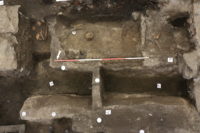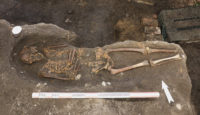 Archaeologists excavating in Trondheim, Norway, have discovered a surprise cemetery with individual burials dating to the Middle Ages. The site is in the medieval town center of Trondheim. Whenever new construction is planned in this area, an archaeological survey is automatically triggered. With a new art gallery scheduled to be built at 36-38 Kjøpmannsgata, archaeologists from the Norwegian Institute for Cultural Heritage Research (NIKU) were engaged to excavate from June to October.
Archaeologists excavating in Trondheim, Norway, have discovered a surprise cemetery with individual burials dating to the Middle Ages. The site is in the medieval town center of Trondheim. Whenever new construction is planned in this area, an archaeological survey is automatically triggered. With a new art gallery scheduled to be built at 36-38 Kjøpmannsgata, archaeologists from the Norwegian Institute for Cultural Heritage Research (NIKU) were engaged to excavate from June to October.
The team expected to find the remains of dwellings, evidence of the metal crafts that were centered there and traces of the town’s beach and coves going back to the 1000s. The soil is sandy — having once been waterfront property — which makes for poor conservation conditions, so they weren’t expecting much in the way organic archaeological material.
 They certainly were not expecting to find a previously unrecorded medieval cemetery. So far approximately 130 square feet of the site have been excavated, and 15 individual graves unearthed. Seven of the interred are adults, five children and the skeletal remains of the other three have not yet been revealed. There are also three mass burial pits. One of those pits was the first discovery indicating the presence of a surprise cemetery. The mass graves turn out to be reinterrals, bones that were removed from other graves and reburied in deep wood-lined pits when the street was developed in the 17th century.
They certainly were not expecting to find a previously unrecorded medieval cemetery. So far approximately 130 square feet of the site have been excavated, and 15 individual graves unearthed. Seven of the interred are adults, five children and the skeletal remains of the other three have not yet been revealed. There are also three mass burial pits. One of those pits was the first discovery indicating the presence of a surprise cemetery. The mass graves turn out to be reinterrals, bones that were removed from other graves and reburied in deep wood-lined pits when the street was developed in the 17th century.
“There are probably even more graves further down. All of these individual graves are in situ, i.e. located in the same place as when they were buried, but several have been partially destroyed. In many cases
only the upper body has been preserved. The lower half can be cut by, for example, other graves being laid over or by later excavation work.” Those were the words of NIKU project manager Silje Rullestad.
The cemetery has been clearly impacted by several stages of building work, but the team can nevertheless see a clear structure. The northern boundary of the area appears to be marked by a ditch, while four post holes suggest a clear boundary mark.
Excavations are ongoing, now under a heated tent on account of it’s  Norway. They expect to find at least another 15 individual graves. The team will also take samples of soil and of the bones to subject them to laboratory analyses.
Norway. They expect to find at least another 15 individual graves. The team will also take samples of soil and of the bones to subject them to laboratory analyses.
“From the archaeological excavation of the St. Clement’s Church churchyard, large variations in the degree of conservation of the skeletons were observed. We also see the same here in Kjøpmannsgata. Using the study, we will try to map out why the differences in conservation conditions vary within small distances,” says Rullestad.
The survey could provide a better understanding of the conditions that affect the preservation of human remains.